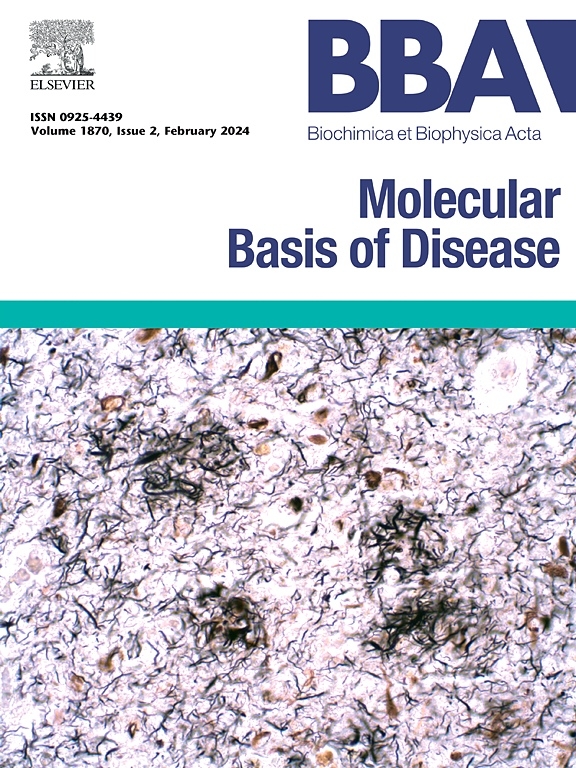胆盐在瘙痒受体激活中的作用。
IF 4.2
2区 生物学
Q2 BIOCHEMISTRY & MOLECULAR BIOLOGY
Biochimica et biophysica acta. Molecular basis of disease
Pub Date : 2025-07-07
DOI:10.1016/j.bbadis.2025.167972
引用次数: 0
摘要
背景:胆汁淤积相关性瘙痒是一种令人痛苦的症状。胆盐和胆红素常与瘙痒的病因有关。我们评估了这些化合物是否激活了已知的瘙痒受体。方法:通过监测胞质游离Ca2+,激活过表达这些受体的细胞中的既定受体TRPA1、TRPV1、TRPV3、TRPV4、MRGPRX4。采用cAMP ELISA法检测TGR5过表达细胞中TGR5的活化情况。分析43例胆汁淤积症患者和15例对照者的血清受体激活情况;采用高效液相色谱-质谱法测定血浆胆盐浓度。结果:结合胆汁盐及其硫酸和葡萄糖醛酸衍生物的血浆水平与瘙痒强度相关;大多数未结合的胆盐没有。TRPA1和MRGPRX4仅在高浓度时被胆盐激活。胆红素仅弱激活MRGPRX4。然而,生理水平的白蛋白完全消除了这些激活。受体表达细胞与患者血清(含白蛋白)孵育没有激活任何瘙痒受体。相反,白蛋白的生理浓度降低了但并没有完全消除胆盐诱导的TGR5激活,这种激活的程度与瘙痒的强度相关。然而,TGR5激活也可由ntcp缺乏个体的血浆诱导。结论:虽然TGR5的激活与瘙痒相关,但NTCP缺乏患者的血浆也激活了该受体,表明TGR5的激活不是主导因素。在存在生理白蛋白浓度的情况下,受体激活的缺失表明胆盐和胆红素在这些受体的激活中没有直接作用。本文章由计算机程序翻译,如有差异,请以英文原文为准。
The role of bile salts in itch receptor activation
Background
Cholestasis-associated pruritus is a distressing symptom. Bile salts and bilirubin are often implicated in the etiology of pruritus. We evaluated whether these compounds activate known itch receptors.
Methods
Activation of the established pruriceptors TRPA1, TRPV1, TRPV3, TRPV4, MRGPRX4 in cells overexpressing these receptors, by monitoring cytosolic free Ca2+. TGR5 activation was assayed by means of cAMP ELISA in TGR5 overexpressing cells. Serum from 43 cholestatic patients and 15 controls was analyzed for receptor activation; plasma bile salt concentrations were quantified by HPLC-MS.
Results
Plasma levels of conjugated bile salts and their sulphated and glucuronidated derivatives correlated with pruritus intensity; most unconjugated bile salts did not. TRPA1 and MRGPRX4 were activated by bile salts only at high concentrations. Bilirubin only weakly activated MRGPRX4. However, physiological levels of albumin completely abrogated these activations. Incubation of receptor-expressing cells with patient serum (containing albumin) did not activate any of the itch receptors. In contrast, physiological concentrations of albumin reduced but did not completely abrogate bile salt-induced TGR5 activation, and the extent of this activation correlated with pruritus intensity. However, TGR5 activation was also induced by plasma from NTCP-deficient individuals.
Conclusion
While TGR5 activation correlates with pruritus, this receptor was also activated by plasma of NTCP deficient patients who do not suffer from pruritus, indicating that activation of TGR5 is not a dominant factor. The absence of receptor activation in the presence of physiological concentrations of albumin indicates that bile salts and bilirubin do not play a direct role in activation of these receptors.
求助全文
通过发布文献求助,成功后即可免费获取论文全文。
去求助
来源期刊
CiteScore
12.30
自引率
0.00%
发文量
218
审稿时长
32 days
期刊介绍:
BBA Molecular Basis of Disease addresses the biochemistry and molecular genetics of disease processes and models of human disease. This journal covers aspects of aging, cancer, metabolic-, neurological-, and immunological-based disease. Manuscripts focused on using animal models to elucidate biochemical and mechanistic insight in each of these conditions, are particularly encouraged. Manuscripts should emphasize the underlying mechanisms of disease pathways and provide novel contributions to the understanding and/or treatment of these disorders. Highly descriptive and method development submissions may be declined without full review. The submission of uninvited reviews to BBA - Molecular Basis of Disease is strongly discouraged, and any such uninvited review should be accompanied by a coverletter outlining the compelling reasons why the review should be considered.

 求助内容:
求助内容: 应助结果提醒方式:
应助结果提醒方式:


